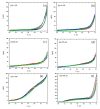Development and characterization of a diamond-insulated graphitic multi electrode array realized with ion beam lithography
- PMID: 25558992
- PMCID: PMC4327033
- DOI: 10.3390/s150100515
Development and characterization of a diamond-insulated graphitic multi electrode array realized with ion beam lithography
Abstract
The detection of quantal exocytic events from neurons and neuroendocrine cells is a challenging task in neuroscience. One of the most promising platforms for the development of a new generation of biosensors is diamond, due to its biocompatibility, transparency and chemical inertness. Moreover, the electrical properties of diamond can be turned from a perfect insulator into a conductive material (resistivity ~mΩ·cm) by exploiting the metastable nature of this allotropic form of carbon. A 16‑channels MEA (Multi Electrode Array) suitable for cell culture growing has been fabricated by means of ion implantation. A focused 1.2 MeV He+ beam was scanned on a IIa single-crystal diamond sample (4.5 × 4.5 × 0.5 mm3) to cause highly damaged sub-superficial structures that were defined with micrometric spatial resolution. After implantation, the sample was annealed. This process provides the conversion of the sub-superficial highly damaged regions to a graphitic phase embedded in a highly insulating diamond matrix. Thanks to a three-dimensional masking technique, the endpoints of the sub-superficial channels emerge in contact with the sample surface, therefore being available as sensing electrodes. Cyclic voltammetry and amperometry measurements of solutions with increasing concentrations of adrenaline were performed to characterize the biosensor sensitivity. The reported results demonstrate that this new type of biosensor is suitable for in vitro detection of catecholamine release.
Figures





Similar articles
-
A new diamond biosensor with integrated graphitic microchannels for detecting quantal exocytic events from chromaffin cells.Adv Mater. 2013 Sep 14;25(34):4696-700. doi: 10.1002/adma.201300710. Epub 2013 Jul 12. Adv Mater. 2013. PMID: 23847004
-
Microelectrode Arrays of Diamond-Insulated Graphitic Channels for Real-Time Detection of Exocytotic Events from Cultured Chromaffin Cells and Slices of Adrenal Glands.Anal Chem. 2016 Aug 2;88(15):7493-9. doi: 10.1021/acs.analchem.5b04449. Epub 2016 Jul 18. Anal Chem. 2016. PMID: 27376596
-
Electrical stimulation of non-classical photon emission from diamond color centers by means of sub-superficial graphitic electrodes.Sci Rep. 2015 Oct 29;5:15901. doi: 10.1038/srep15901. Sci Rep. 2015. PMID: 26510889 Free PMC article.
-
Chemical Modification of Boron-Doped Diamond Electrodes for Applications to Biosensors and Biosensing.Crit Rev Anal Chem. 2016 May 3;46(3):248-56. doi: 10.1080/10408347.2015.1082125. Crit Rev Anal Chem. 2016. PMID: 26337147 Review.
-
Planar Diamond-Based Multiarrays to Monitor Neurotransmitter Release and Action Potential Firing: New Perspectives in Cellular Neuroscience.ACS Chem Neurosci. 2017 Feb 15;8(2):252-264. doi: 10.1021/acschemneuro.6b00328. Epub 2017 Jan 20. ACS Chem Neurosci. 2017. PMID: 28027435 Review.
Cited by
-
Electrochemical measurement of quantal exocytosis using microchips.Pflugers Arch. 2018 Jan;470(1):97-112. doi: 10.1007/s00424-017-2063-2. Epub 2017 Sep 2. Pflugers Arch. 2018. PMID: 28866728 Free PMC article. Review.
-
Surface-modified CMOS IC electrochemical sensor array targeting single chromaffin cells for highly parallel amperometry measurements.Pflugers Arch. 2018 Jan;470(1):113-123. doi: 10.1007/s00424-017-2067-y. Epub 2017 Sep 9. Pflugers Arch. 2018. PMID: 28889250 Free PMC article. Review.
-
All-carbon multi-electrode array for real-time in vitro measurements of oxidizable neurotransmitters.Sci Rep. 2016 Feb 9;6:20682. doi: 10.1038/srep20682. Sci Rep. 2016. PMID: 26857940 Free PMC article.
-
Analytical Determination of Serotonin Exocytosis in Human Platelets with BDD-on-Quartz MEA Devices.Biosensors (Basel). 2024 Jan 31;14(2):75. doi: 10.3390/bios14020075. Biosensors (Basel). 2024. PMID: 38391994 Free PMC article.
-
Quantal Release of Dopamine and Action Potential Firing Detected in Midbrain Neurons by Multifunctional Diamond-Based Microarrays.Front Neurosci. 2019 Apr 9;13:288. doi: 10.3389/fnins.2019.00288. eCollection 2019. Front Neurosci. 2019. PMID: 31024230 Free PMC article.
References
-
- Human Brain Project. [(accessed on 20 October 2014)]. Available online: https://www.humanbrainproject.eu/it/home.
-
- National Institute of Health The Brain Initiative. [(accessed on 20 October 2014)]. Available online: http://www.braininitiative.nih.gov/index.htm.
-
- Coupland R.E. The Natural History of the Chromaffin Cell. Longmans Green and Co Ltd.; London, UK: 1965.
-
- Wightman R.M., Jankowski J.A., Kennedy R.T., Kawagoe D.T., Schroeder T.J., Leszczyszyn D.J., Near J.A., Diliberto E.J., Jr., Viveros O.H. Temporally resolved catecholamine spikes correspond to single vesicle release from individual chromaffin cells. Proc. Natl. Acad. Sci. USA. 1991;88:10754–10758. - PMC - PubMed
-
- Ciolkowski E.L., Maness K.M., Cahill P.S., Wightman R.M., Evans D.H., Fosset B., Amatore C. Disproportionation during Electro-oxidation of Catecholamines at Carbon-Fiber Microelectrodes. Anal. Chem. 1994;66:3611–3617.
Publication types
MeSH terms
Substances
LinkOut - more resources
Full Text Sources
Other Literature Sources

